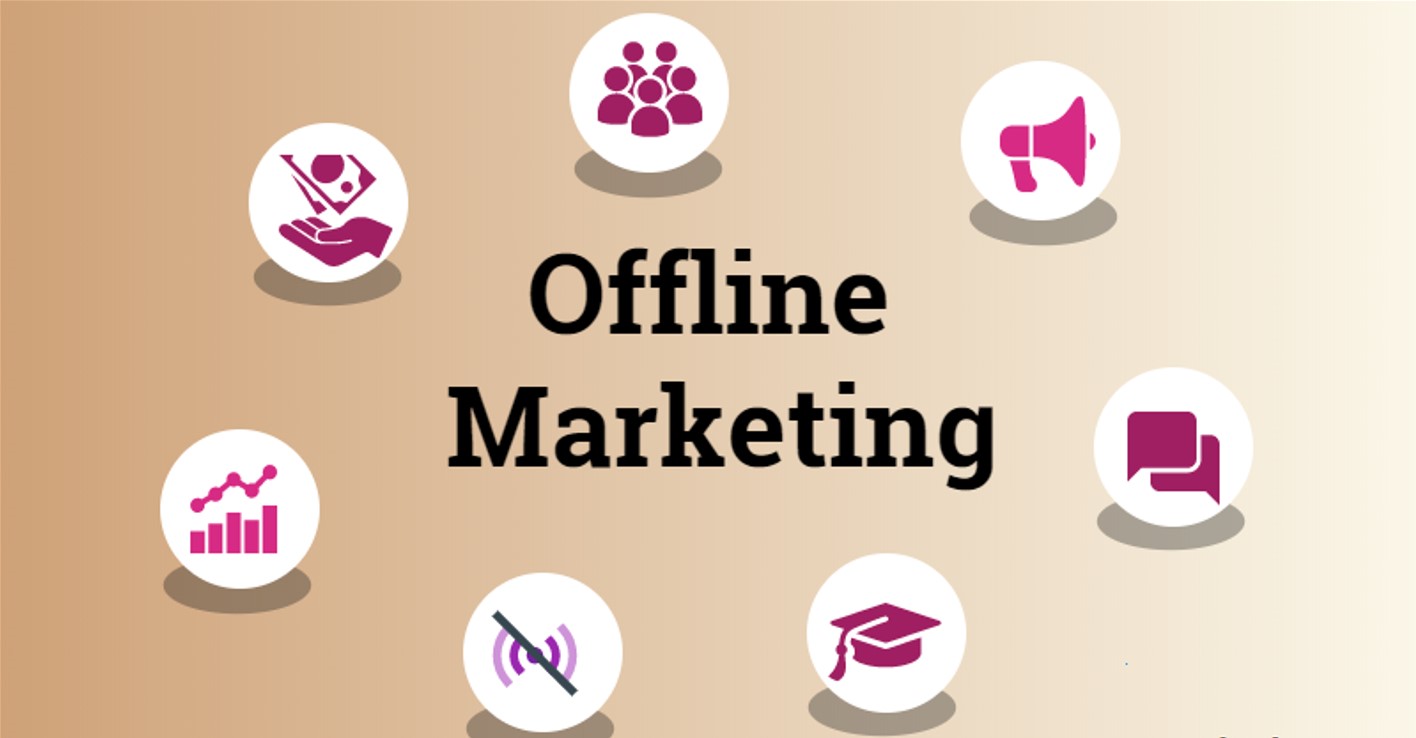Beyond the Screen: Unleashing the Potential of Offline Marketing Strategies
Are you tired of scrolling through an endless stream of online ads, only to be bombarded with even more ads on your social media feed? You’re not alone!
While online marketing has taken the world by storm, it’s important not to overlook the power of offline marketing strategies. Yes, you read that right – good old-fashioned marketing tactics can still be effective in today’s digital world.
In this article, we’ll explore the benefits of offline marketing and share some tips on how to unleash its potential.
So, sit back, relax, and let’s dive into the world beyond the screen!
What is Offline Marketing?
When you hear the term “offline marketing”, it refers to any advertising or promotional activity that doesn’t take place online. This can include things like billboards, TV and radio commercials, direct mail campaigns, event sponsorships, and promotional products.
Basically, it’s any type of marketing that you encounter in the physical world, rather than on a screen. While digital marketing has become increasingly popular in recent years, offline marketing can still be incredibly effective.
In fact, many companies have found that combining offline and online marketing strategies can be a winning combination for reaching their target audience. So don’t overlook the power of offline marketing when developing your next marketing plan!
The Benefits of Offline Marketing
Here are the benefits of offline marketing
Increased Brand Recognition
One of the biggest benefits of offline marketing is increased brand recognition. When you advertise your business in the physical world through things like billboards, direct mail campaigns, or promotional products, you’re more likely to stick in people’s minds.
Think about it – if you see a billboard for a company on your daily commute, you’re going to be more likely to remember their name and what they do. By increasing your brand recognition through offline marketing efforts, you’re making it easier for people to remember and recognize your business.
And when they’re in need of the products or services you offer, they’re more likely to turn to you as a result.
Targeting Specific Demographics
Offline marketing can be great for targeting specific demographics. By identifying the types of people most likely to be interested in your product or service, you can focus your efforts on reaching them through offline channels.
For example, if your target demographic is older adults, you might consider advertising in print magazines or newspapers. Or if you’re looking to reach a younger crowd, you might sponsor a music festival or use social media influencers to promote your brand.
The key is to understand who your ideal customer is and what types of offline marketing tactics will appeal to them. By tailoring your efforts to specific demographics, you can increase the chances of reaching the right people and making a meaningful connection.
Personalized Customer Experience
Offline marketing can be a great way to create a personalized customer experience that can be hard to replicate online. When you’re able to interact with potential customers in person, you have the opportunity to create a unique experience that feels tailored to their needs and preferences.
For example, you might host an event where customers can try your products or services in person, or you might send out personalized direct mail pieces that speak directly to their interests.
Another way to personalize offline marketing strategies is to use data and analytics to target customers with messages and offers that are relevant to them. By making the effort to create a personalized customer experience, you can build stronger connections with your audience and increase the chances of converting them into loyal customers.
Higher Engagement and Response Rates
When it comes to engagement and response rates, offline marketing can often outperform online marketing efforts. While digital marketing can certainly be effective, it’s also become increasingly crowded and competitive.
As a result, it can be harder to stand out and capture people’s attention. With offline marketing, on the other hand, you have the opportunity to create a more memorable and impactful experience for potential customers.
For example, someone might receive a direct mail piece that catches their eye and prompts them to take action, whereas they might simply scroll past an online ad without really noticing it.
By creating a more engaging and personal experience through offline marketing, you can increase the chances of people responding to your message and taking the desired action. So if you’re looking to boost engagement and response rates, offline marketing might be a smart choice.
5 Offline Marketing Strategies to Consider

1. Direct Mail Campaigns
Direct mail campaigns can be a highly effective offline marketing strategy. By sending physical mail to potential customers, you have the opportunity to make a more personal connection and stand out from the sea of online ads and emails.
Plus, direct mail campaigns can be highly targeted and personalized based on factors like demographics and past purchase history. Some successful direct mail campaigns have included things like personalized postcards or letters, promotional offers, and free samples or trial offers.
For example, a restaurant might send out a direct mail piece that includes a coupon for a free appetizer, or a beauty brand might send out a sample of a new product with a personalized note.
By providing value and creating a sense of exclusivity, direct mail campaigns can be a highly effective way to generate interest and drive action from potential customers.
2. Event Sponsorships
Sponsoring events can be a powerful offline marketing strategy that can help increase brand awareness and generate leads. By associating your brand with a well-regarded event or organization, you can help build credibility and trust with potential customers.
Additionally, event sponsorships often come with opportunities to showcase your products or services and engage with attendees in a more personal way. To choose the right events to sponsor, start by considering your target audience and what types of events they might be interested in attending.
Look for events that align with your brand values and mission, and consider the size and demographics of the expected audience.
Finally, think about the level of exposure and benefits that come with each sponsorship opportunity – will you have a booth or speaking slot, for example, or will your logo be prominently displayed on event materials?
3. Billboards and Other Outdoor Advertising
Outdoor advertising, such as billboards, posters, and flyers, remains a valuable way to build brand awareness and attract new customers. By strategically placing your ads in high-traffic areas, you can ensure maximum visibility and exposure.
Outdoor advertising can be highly customizable and effective in promoting your brand, from traditional billboards to digital signage. In creating your outdoor ad, factors like location, design, messaging, and even the flyer sizes are essential in capturing the attention of passersby.
With the right approach, outdoor advertising can be a powerful tool for your offline marketing strategy that helps generate brand awareness and drive business growth.
4. Promotional Products and Merchandise
Promotional products and merchandise can be a fun and creative way to get your brand in front of potential customers.
By creating custom products like t-shirts, mugs, or keychains with your company logo or messaging, you can create a sense of brand loyalty and increase awareness of your business. Additionally, promotional products can serve as a way to thank existing customers and encourage repeat business.
When choosing promotional products, think about what items will be most useful or appealing to your target audience. Consider factors like cost, durability, and branding opportunities to ensure that your promotional products are effective and high-quality.
With the right approach, promotional products can be a valuable component of your offline marketing strategy.
5. Print Ads in Magazines and Newspapers
Print ads in magazines and newspapers can be a tried-and-true way to reach a specific audience with your marketing message.
By placing ads in publications that your target audience is likely to read, you can ensure that your message is seen by a group of people who are already interested in the type of product or service you offer. Print ads can take many forms, from full-page spreads to smaller classified ads, and can be customized based on your goals and budget.
When designing your print ad, it’s important to consider factors like visual appeal, message clarity, and call-to-action. With the right approach, print ads in magazines and newspapers can be a cost-effective and impactful way to promote your business and generate leads.
How to Measure the Success of Your Offline Marketing Campaign
Let’s discuss how to measure the success of your offline marketing campaign
Setting Goals and KPIs
Setting goals and KPIs (key performance indicators) is a crucial step in creating an effective offline marketing strategy. By defining specific, measurable goals for your campaign, you can ensure that you are working toward a clear objective and can measure your success over time.
Examples of goals might include generating a certain number of leads or sales, increasing brand awareness, or driving traffic to a specific landing page or website. Once you have set your goals, you can identify the KPIs that will help you track progress and measure success.
For example, if your goal is to generate leads, you might track the number of leads generated or the conversion rate of a specific landing page. By setting clear goals and KPIs, you can stay focused on the outcomes that matter most and make data-driven decisions about your marketing strategy.
Tracking Response Rates and Customer Feedback
Tracking response rates and customer feedback is essential for understanding the effectiveness of your offline marketing campaign.
Response rates can help you understand how many people are engaging with your campaign and how successful it is in generating leads or sales. You can track response rates by using unique coupon codes or phone numbers, or by monitoring website traffic and social media engagement.
In addition to tracking response rates, it’s important to gather feedback from customers to understand their experience with your campaign and what they liked or didn’t like about it. This feedback can help you refine your strategy and make adjustments to better meet the needs and preferences of your target audience.
By tracking response rates and gathering customer feedback, you can gain valuable insights into the success of your offline marketing campaign and make data-driven decisions about future strategies.
Analyzing Sales Data and ROI
Analyzing sales data and ROI (return on investment) is a critical step in measuring the success of your offline marketing campaign. By tracking sales data, you can determine how much revenue your campaign generated and calculate your ROI.
To analyze your sales data, you can compare your sales during the campaign period to your typical sales patterns, or compare your sales to the sales of a control group that was not exposed to your campaign.
This will give you a sense of how much impact your campaign had on your sales. Calculating ROI involves comparing the revenue generated by your campaign to the cost of the campaign, including materials, printing, and any other expenses.
By analyzing sales data and calculating ROI, you can determine whether your campaign was cost-effective and identify opportunities for improvement in future campaigns.
Integrating Offline and Online Marketing
Here are the top ways to integrate offline and online marketing
Using QR Codes and Personalized URLs
Generate QR codes and create personalized URLs that are powerful for integrating offline and online marketing. QR codes are easy to create and can be added to any printed material, such as flyers, brochures, and posters.
When scanned with a smartphone camera, QR codes can lead customers to a personalized URL, where they can learn more about your products and services or make a purchase. Personalized URLs are unique web addresses that are customized for each customer or target audience.
By using personalized URLs, you can track customer engagement with your campaign and provide a personalized experience for each customer.
By incorporating QR codes and personalized URLs into your offline marketing strategies, you can seamlessly connect your offline and online marketing efforts and create a more cohesive and effective marketing campaign.
Social Media Integration
Integrating social media into your offline marketing campaigns is an effective way to expand your reach and create a more engaging customer experience. Social media platforms like Facebook, Instagram, and Twitter allow you to connect with your customers on a personal level and promote your offline marketing campaigns.
By creating posts, stories, and ads that showcase your campaign and using attention-grabbing Instagram captions, you can encourage customers to engage with your campaign and drive traffic to your website.
This seamless integration of social media and offline marketing efforts can help you create a more holistic marketing strategy that delivers results.
Creating a Seamless Customer Experience
Creating a seamless customer experience is crucial when integrating offline and online marketing strategies. You want to make sure that the transition from offline to online is smooth and effortless for your customers.
One way to do this is by maintaining consistent branding across all platforms. This includes using the same colors, fonts, and messaging in both your offline and online marketing materials.
Additionally, you should make it easy for customers to find your online presence by including your website and social media handles on your offline marketing materials. Finally, you should make sure that your online platforms are optimized for mobile devices, as many customers will likely be accessing them from their smartphones.
By creating a seamless customer experience, you can enhance the effectiveness of your offline and online marketing efforts and build a stronger connection with your customers.
Key Takeaways
In summary, offline marketing strategies offer numerous benefits, including increased brand recognition, personalized customer experiences, and higher engagement and response rates.
Direct mail campaigns, event sponsorships, billboards and outdoor advertising, promotional products and merchandise, and print ads in magazines and newspapers are just a few of the many tactics that businesses can use to reach customers offline.
It’s important to remember that offline and online marketing strategies should work together in a balanced approach. By integrating these strategies and creating a seamless customer experience, businesses can enhance the effectiveness of their marketing efforts and build stronger connections with their customers.
Ultimately, a balanced marketing strategy that incorporates both offline and online tactics can help businesses reach a wider audience, increase brand recognition, and drive sales.
By understanding the benefits of offline marketing and utilizing these tactics alongside online efforts, businesses can create a comprehensive marketing plan that engages customers both online and offline.
Read More:Top 10 Transformative Technologies and Trends for Marketing in 2023



